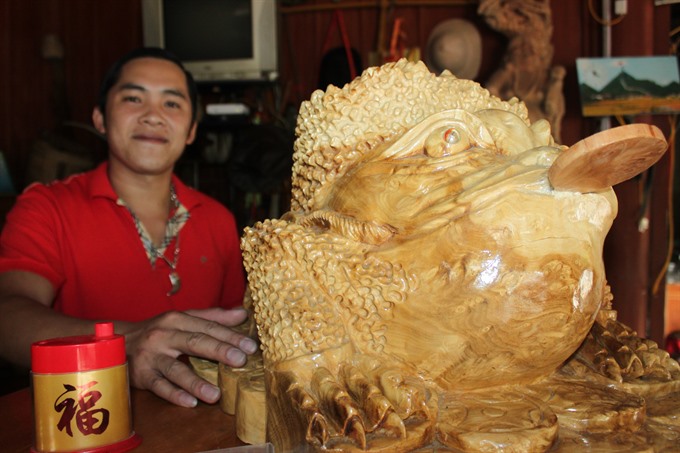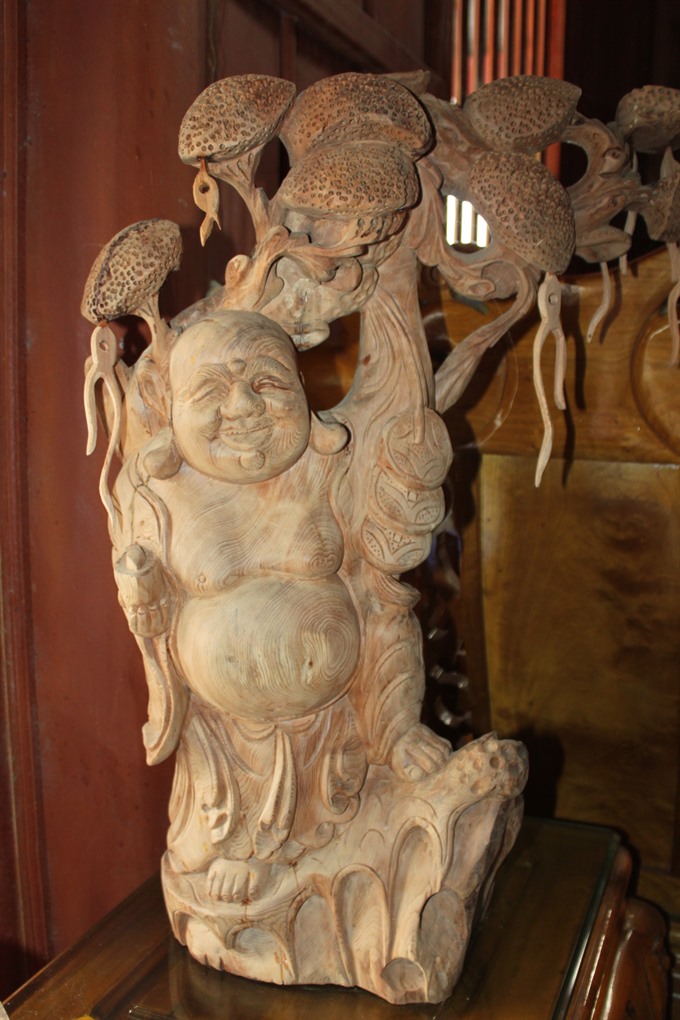 Features
Features

Phàn Giào Huẩn, 31, a man of Mông ethnicity in the northern province of Hà Giang’s Thuận Hòa Village, is not an artisan but has become rich through his artworks carved from waste wood.
 |
| Wooden wonder: Huẩn and his wooden sculpture of a toad holding a penny. VNS Photo Trần Hòa |
by Trần Hòa
Phàn Giào Huẩn, 31, a man of Mông ethnicity in the northern province of Hà Giang’s Thuận Hòa Village, is not an artisan but has become rich through his artworks carved from waste wood.
The types of wood he uses are known as gỗ lũa (the firmest core at the root of dead ancient trees) and bìu nghiến (lumpy plank block).
Arriving at his house on stilts, we were intrigued by the Mông people’s tools and wooden artworks on display.
“These wooden artworks seemed to be imbued with a mysterious beauty that could almost be recognised as a soul,” said one of my friends.
Born to poor family with seven children, Huấn had to drop out of school after the fourth grade, to help his parents work on their fields, raise buffalo, and fetch firewood from the forest.
“Each time I went to the forest, I took note of the illegal deforestation, which was causing so much damage to the area. I thought of how my descendants would have firewood to cook. When I grew up, I recognised the seriousness of this damage, so I volunteered to join a group protecting the forests,” Huẩn said.
At the age of 19 he became an official volunteer with the provincial forest rangers in Vị Xuyên District of Hà Giang.
“To patrol the large forests, we have to work long days and late at night to find where the illegal deforestation is taking place,” Huẩn said, adding that sometimes his team lived for up to a month in the wilderness, but "nobody in team has complained".
Although working as volunteer, Huẩn devotes his efforts to helping his fellow rangers, because he is so knowledgeable on the local terrain.
He told us that one day while going to the forest for firewood he saw a group of illegal loggers. “I was trying to run to alert the forest rangers but the men rushed after me and threatened to kill me. I was very afraid but I managed to fight them. I was able to escape because I know these forests by heart,” he said.
At other times, he heard sawing in the middle of the night, and rushed to tell the forest rangers. They caught all the loggers on the spot.
The head of the forest rangers, Tráng A Tung, said “Huẩn has made a great contribution in helping us catch the poachers. Without his help, we would be facing a much more difficult task.”
Apart from working as a forest protector, Huẩn tries to promote the values of the forest to his fellow villagers.
“I tell them that if we keep the forest alive, it will serve the Mông’s livelihood. I mean that we would still have firewood to cook meals. At first they didn’t agree with me, but I persevered in talking to them individually about how we are killing the forest around us. Finally, many young men in the village have volunteered to join the rangers to protect the forests,” he said.
 |
| Intricate design: A popular sculpture carved by Huan out of wood. |
Over more than a decade of voluntary work, Huẩn often found himself picking up waste timbers and other bits of driftwood scattered in streams or rivers.
“When I brought these bits of wood home, my parents and neighbours thought I was haunted by ghosts,” said Huẩn.
Once, on a visit to Hà Nội, he chanced upon a fine arts shop specialising in artwork carved from wood.
On returning to his village, Huẩn picked up the search for discarded tree roots and other waste wood soaked in streams or rivers.
At home, he browsed the internet and read books and newspapers to learn about the art of wood carving. After many aborted attempts, he finally found success in carving pieces that were valued at millions of đồng.
As a result, after several years honing his craft and producing beautiful works, Huẩn has become a rich man in his village. Many customers from Hà Nội and HCM City have ordered his items.
“I’m not damaging the forests for these bits of wood, I found them scattered in streams or rivers over the years. I then bring them home to make artworks,” Huẩn said.
There are still a large amount of wood left to collect in the forests, and Hà Giang Province’s streams and rivers. “I will continue my efforts to find these materials and turn them into beautiful artworks. I plan to teach the art to the young villagers who wish to learn,” he said. VNS




